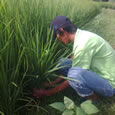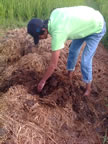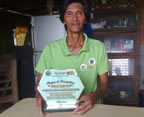Feature Article - January 15, 2016
SRI Stories: Meet Federico Rullamas, an SRI Farmer in La Union, Philippines
By Roberto Verzola, SRI-Pilipinas
Born on February 10, 1968, in the village of Santa Rita, Aringay, in the province of La Union, to parents Jose and Anastacia Rullamas, Federico Rullamas has been a farmer all his life. His farm covers 1.5 hectares, which he plants with rice, corn and an occasional cash crop. He once tried onions, but it was "too price sensitive," he says.
 Freddie is one of the six who tried the System of Rice Intensification (SRI) during 2012 rainy season in Aringay, La Union. In his first trial, which covered only 120 square meters, he harvested the equivalent of 8.3 tons/hectare based on the crop cut done by the municipal agriculturalist office. His conventional field yielded only 5 tons per hectare. In 2013, Freddie set aside half of a hectare for his SRI trial. He harvested the equivalent of 9.3 tons per hectare. In his conventional field, he got 6 tons per hectare. In 2014, he tried again, in 0.6 hectares. His SRI trial yielded 10 tons/ha, while his conventional field produced 5 tons/ha.
Freddie is one of the six who tried the System of Rice Intensification (SRI) during 2012 rainy season in Aringay, La Union. In his first trial, which covered only 120 square meters, he harvested the equivalent of 8.3 tons/hectare based on the crop cut done by the municipal agriculturalist office. His conventional field yielded only 5 tons per hectare. In 2013, Freddie set aside half of a hectare for his SRI trial. He harvested the equivalent of 9.3 tons per hectare. In his conventional field, he got 6 tons per hectare. In 2014, he tried again, in 0.6 hectares. His SRI trial yielded 10 tons/ha, while his conventional field produced 5 tons/ha.
Aside from his SRI trials, Freddie also likes to try out all kinds of rice varieties. He has tried Jasmine, local varieties like Sinandomeng and Dalagang bukid, the government variety BPI 76 (red), an Indonesian variety called DSU 300, farmer-developed lines like VG 13, VG 14 and PGR 165, and the variety SL-18, a hybrid distributed by the municipality. "It's weak," he says of the hybrid. He has also tried "super green rice," but was not impressed. The varieties he got from SRI Pilipinas, the national SRI network in the Philippines, were better, he says. His favorite was a glutinous variety he calls "lagkitan."
Increasing the Yield
Freddie loves to try all kinds of things to improve his yield. Once, he borrowed eight buffaloes. He let them loose for three days on a 3,400-square meter rice field to "play around." And this is what he observed: Previously, he was getting 30 sacks of rice from the rice field. After, he got 40 sacks. He tried it again in the next planting season, he got 45. "It turned out to be a good thing." he noted.
"Without any plowing, without any gasoline or labor spent, it's as if the field went through a round with a hand tractor.  It even looks deeply plowed. All it needed afterwards was a final round of harrowing, to level the soil. All the dung and buffalo urine made the field so fertile, that I only needed a small amount of compost to top it off."
It even looks deeply plowed. All it needed afterwards was a final round of harrowing, to level the soil. All the dung and buffalo urine made the field so fertile, that I only needed a small amount of compost to top it off."
Not content with the 25x25 cm planting distance he learned from SRI Pilipinas, Freddie tried other distances: 20x20,25x25, 30x30, and 25x30. "The space was too tight,” was his comment on the 20x20 distance. “It was the 30x30 that made the best use of space,” he added.
Freddie puts 100 bags of compost on his 8,000-square meter rice field. He also uses the “soil nutrient enhancer” he learned from Venancio Garde Jr., the national trainer of SRI Pilipinas. "Didn't it cost too much?" I asked. "Not if you make the compost yourself," he replied. For every bag of compost he makes, Freddie spends only fifty pesos (slightly more than a US dollar).
Freddie makes his compost out of the following materials: rice straw (his own or scrounged from neighbors); buffalo, goat and chicken dung; various agricultural wastes; and molasses, to speed up the decomposition. Molasses helps the decomposing bacteria reproduce faster, he explains. The most important ingredient in his compost, Freddie says, is “bannog” (hard work).
Plenty of Recognition Comes His Way!
 And his hard work was amply rewarded. On February 24, 2014, with his entire family, Freddie was given the "Outstanding Farm Family" award by La Union Governor Manuel C. Ortega. On top of that, he was one of several farmers who received awards as "Outstanding Agricultural Achievers" for 2014 (right). Finally, to continue his string of recognitions, during 2015 his second season crop of high-value organic red rice not only fetched him a very good price in the market, his yield of 170 cavans per hectare also won him the "Highest Yielder for Naturally Grown Organic Rice Farming" award in 2015. (See Philippine Daily Inquirer article for details).
And his hard work was amply rewarded. On February 24, 2014, with his entire family, Freddie was given the "Outstanding Farm Family" award by La Union Governor Manuel C. Ortega. On top of that, he was one of several farmers who received awards as "Outstanding Agricultural Achievers" for 2014 (right). Finally, to continue his string of recognitions, during 2015 his second season crop of high-value organic red rice not only fetched him a very good price in the market, his yield of 170 cavans per hectare also won him the "Highest Yielder for Naturally Grown Organic Rice Farming" award in 2015. (See Philippine Daily Inquirer article for details).
Indeed, who will not be impressed by a farmer whose hard work sent three children to school until they finished their college education, and yet keeps trying how he can improve his farm operations?

